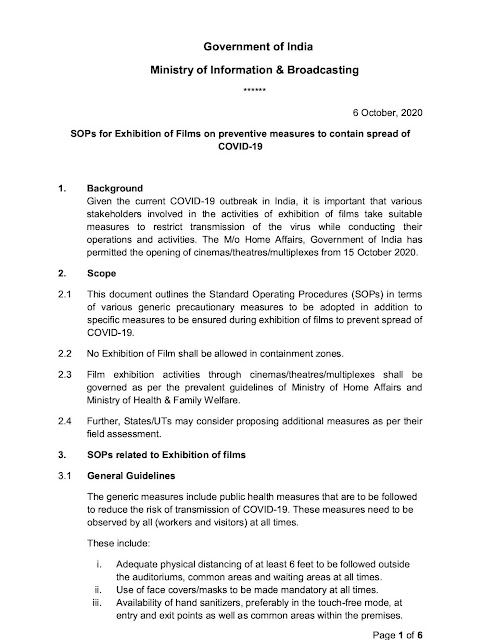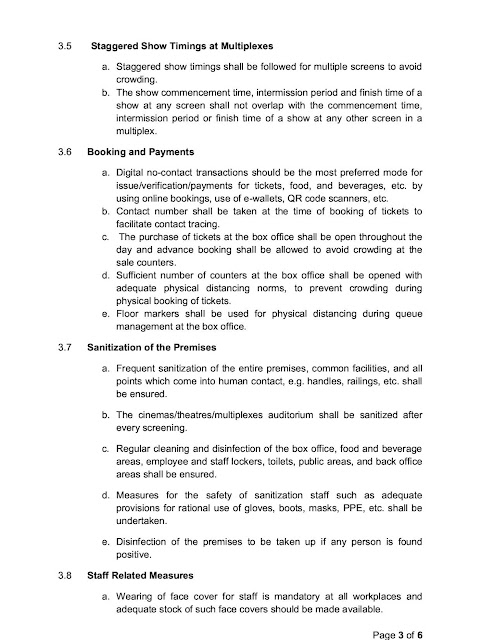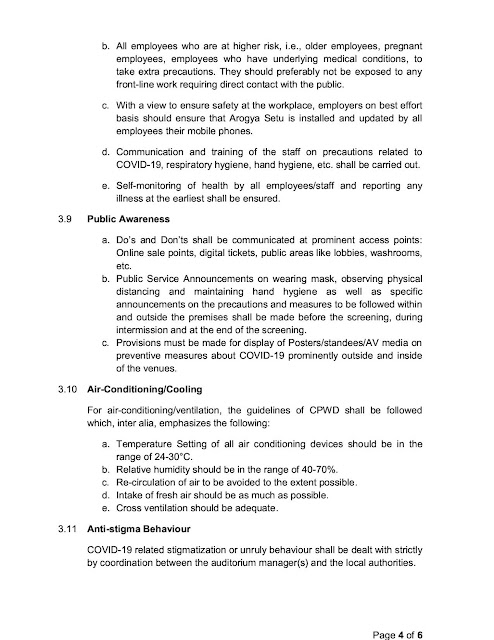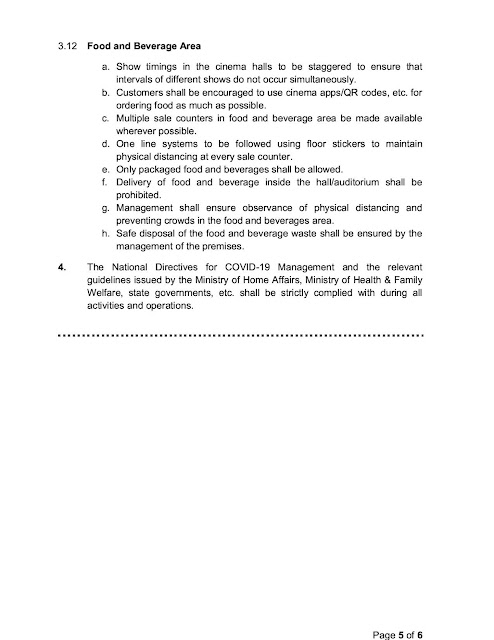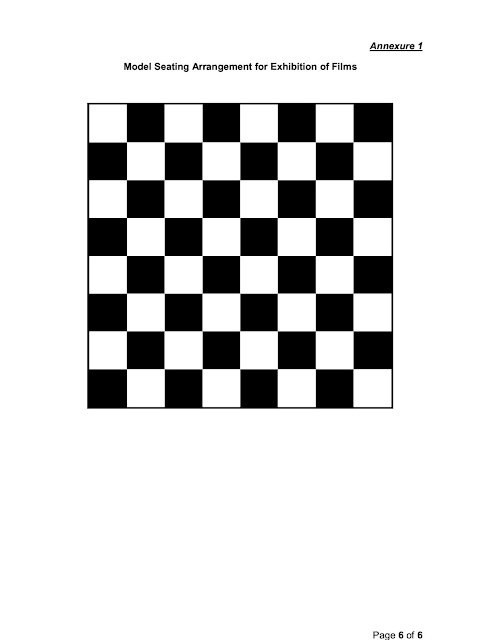Guidelines for Exhibition of Films on preventive measures to contain spread of COVID-19
Ministry of Information and Broadcasting has released the Guidelines for Exhibition of Films on preventive measures to contain spread of COVID-19. The generic measures include public health measures that are to be followed to reduce the risk of transmission of COVID-19. These measures need to be observed by all (workers and visitors) at all times.
Government of India
Ministry of Information & Broadcasting
******
6 October, 2020
SOPs for Exhibition of Films on preventive measures to contain spread of COVID-19
1. Background
Given the current COVID-19 outbreak in India, it is important that various stakeholders involved in the activities of exhibition of films take suitable measures to restrict transmission of the virus while conducting their operations and activities. The M/o Home Affairs, Government of India has permitted the opening of cinemas/theatres/multiplexes from 15 October 2020.
2. Scope
2.1 This document outlines the Standard Operating Procedures (SOPs) in terms of various generic precautionary measures to be adopted in addition to specific measures to be ensured during exhibition of films to prevent spread of COVID-19.
2.2 No Exhibition of Film shall be allowed in containment zones.
2.3 Film exhibition activities through cinemas/theatres/multiplexes shall be governed as per the prevalent guidelines of Ministry of Home Affairs and Ministry of Health & Family Welfare.
2.4 Further, States/UTs may consider proposing additional measures as per their field assessment.
3. SOPs related to Exhibition of films
3.1 General Guidelines
The generic measures include public health measures that are to be followed to reduce the risk of transmission of COVID-19. These measures need to be observed by all (workers and visitors) at all times.
These include:
i. Adequate physical distancing of at least 6 feet to be followed outside the auditoriums, common areas and waiting areas at all times.
ii. Use of face covers/masks to be made mandatory at all times.
iii. Availability of hand sanitizers, preferably in the touch-free mode, at entry and exit points as well as common areas within the premises.
iv. Respiratory etiquettes to be strictly followed. This involves strict practice of covering one’s mouth and nose while coughing/sneezing with a tissue/handkerchief/flexed elbow and disposing off used tissues properly.
v. Self-monitoring of health by all and reporting any illness at the earliest to state and district helpline.
vi. Spitting shall be strictly prohibited.
vii. Installation & use of Aarogya Setu App shall be advised to all.
3.2 Entry & Exit Points
a. Thermal screening of visitors/staff is to be carried out at entry points. Only asymptomatic individuals shall be allowed to enter the premises.
b. Provisions for hand sanitization should be made available at all entry points and in work areas.
c. Designated queue markers shall be made available for entry and exit of the audience from the auditorium and the premises.
d. The Exit should be done in a staggered row-wise manner to avoid crowding.
e. Sufficient time interval between successive screenings on a single screen as well as on various screens in a multiplex shall be provided to ensure row-wise staggered entry and exit of the audience.
3.3 Seating Arrangements
a. The occupancy of the cinemas/theatres/multiplexes shall not be more than 50% of their total seating capacity.
b. Seating arrangement inside the auditorium of the cinemas /theatres / multiplexes to be made in such a way that adequate physical distancing is maintained. A model seating arrangement is attached at Annexure 1.
c. Seats that are “Not to be occupied” shall be marked as such during booking (for both online booking and at the box office sale of tickets).
Note: The “Not to be occupied “seats inside cinemas/theatres/multiplexes should either be taped or marked with fluorescent markers to prevent people from occupying these seats so as to ensure adequate physical distancing at all times.
3.4 Physical Distancing Norms
a. Proper crowd management in the parking lots and outside the premises—duly following physical distancing norms shall be ensured.
b. Number of people in the elevators shall be restricted, duly maintaining physical distancing norms.
c. Efforts shall be made to avoid overcrowding in the common areas, lobbies and washrooms during the intermission. Audience may be encouraged to avoid movement during the intermission. Longer intermissions may be used to allow audience seated in different rows of the auditorium to move in a staggered manner.
3.5 Staggered Show Timings at Multiplexes
a. Staggered show timings shall be followed for multiple screens to avoid crowding.
b. The show commencement time, intermission period and finish time of a show at any screen shall not overlap with the commencement time, intermission period or finish time of a show at any other screen in a multiplex.
3.6 Booking and Payments
a. Digital no-contact transactions should be the most preferred mode for issue/verification/payments for tickets, food, and beverages, etc. by using online bookings, use of e-wallets, QR code scanners, etc.
b. Contact number shall be taken at the time of booking of tickets to facilitate contact tracing.
c. The purchase of tickets at the box office shall be open throughout the day and advance booking shall be allowed to avoid crowding at the sale counters.
d. Sufficient number of counters at the box office shall be opened with adequate physical distancing norms, to prevent crowding during physical booking of tickets.
e. Floor markers shall be used for physical distancing during queue management at the box office.
3.7 Sanitization of the Premises
a. Frequent sanitization of the entire premises, common facilities, and all points which come into human contact, e.g. handles, railings, etc. shall be ensured.
b. The cinemas/theatres/multiplexes auditorium shall be sanitized after every screening.
c. Regular cleaning and disinfection of the box office, food and beverage areas, employee and staff lockers, toilets, public areas, and back office areas shall be ensured.
d. Measures for the safety of sanitization staff such as adequate provisions for rational use of gloves, boots, masks, PPE, etc. shall be undertaken.
e. Disinfection of the premises to be taken up if any person is found positive.
3.8 Staff Related Measures
a. Wearing of face cover for staff is mandatory at all workplaces and adequate stock of such face covers should be made available.
b. All employees who are at higher risk, i.e., older employees, pregnant employees, employees who have underlying medical conditions, to take extra precautions. They should preferably not be exposed to any front-line work requiring direct contact with the public.
c. With a view to ensure safety at the workplace, employers on best effort basis should ensure that Arogya Setu is installed and updated by all employees their mobile phones.
d. Communication and training of the staff on precautions related to COVID-19, respiratory hygiene, hand hygiene, etc. shall be carried out.
e. Self-monitoring of health by all employees/staff and reporting any illness at the earliest shall be ensured.
3.9 Public Awareness
a. Do’s and Don’ts shall be communicated at prominent access points: Online sale points, digital tickets, public areas like lobbies, washrooms, etc.
b. Public Service Announcements on wearing mask, observing physical distancing and maintaining hand hygiene as well as specific announcements on the precautions and measures to be followed within and outside the premises shall be made before the screening, during intermission and at the end of the screening.
c. Provisions must be made for display of Posters/standees/AV media on preventive measures about COVID-19 prominently outside and inside of the venues.
3.10 Air-Conditioning/Cooling
For air-conditioning/ventilation, the guidelines of CPWD shall be followed which, inter alia, emphasizes the following:
a. Temperature Setting of all air conditioning devices should be in the range of 24-30°C.
b. Relative humidity should be in the range of 40-70%.
c. Re-circulation of air to be avoided to the extent possible.
d. Intake of fresh air should be as much as possible.
e. Cross ventilation should be adequate.
3.11 Anti-stigma Behaviour
COVID-19 related stigmatization or unruly behaviour shall be dealt with strictly by coordination between the auditorium manager(s) and the local authorities.
3.12 Food and Beverage Area
a. Show timings in the cinema halls to be staggered to ensure that intervals of different shows do not occur simultaneously.
b. Customers shall be encouraged to use cinema apps/QR codes, etc. for ordering food as much as possible.
c. Multiple sale counters in food and beverage area be made available wherever possible.
d. One line systems to be followed using floor stickers to maintain physical distancing at every sale counter.
e. Only packaged food and beverages shall be allowed.
f. Delivery of food and beverage inside the hall/auditorium shall be prohibited.
g. Management shall ensure observance of physical distancing and preventing crowds in the food and beverages area.
h. Safe disposal of the food and beverage waste shall be ensured by the management of the premises.
4. The National Directives for COVID-19 Management and the relevant guidelines issued by the Ministry of Home Affairs, Ministry of Health & Family Welfare, state governments, etc. shall be strictly complied with during all activities and operations.
***********************************************************************************


